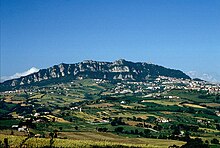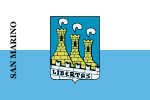City of San Marino
This article needs additional citations for verification. (May 2008) |
City of San Marino
Città di San Marino | |
|---|---|
Capital city and castello | |
Clockwise from top: view of Monte Titano, the aerial tramway, San Marino Cathedral, Via Basilicus, panorama from the top, De La Fratta Tower, Guaita Tower, Palazzo Pubblico | |
 San Marino's location in San Marino | |
| Coordinates: 43°56′4.56″N 12°26′50.28″E / 43.9346000°N 12.4473000°E | |
| Country | |
| Foundation | 3 September 301 (traditional date) |
| Government | |
| • Capitano | Tomaso Rossini (since 2018) |
| Area | |
| • Total | 7.09 km2 (2.74 sq mi) |
| Elevation | 749 m (2,457 ft) |
| Population (January 2022) | |
| • Total | 4,061[1] |
| • Density | 582.23/km2 (1,508.0/sq mi) |
| Time zone | UTC+1 (CET) |
| • Summer (DST) | UTC+2 (CEST) |
| Postal code | RSM-47890 |
| Climate | Cfb |
| UNESCO World Heritage Site | |
|---|---|
 Monte Titano and three fortresses on top of it can be seen from many kilometers away | |
| Criteria | Cultural: iii |
| Reference | 1245 |
| Inscription | 2008 (32nd Session) |
| Area | 55 ha |
| Buffer zone | 167 ha |
The City of San Marino (Italian: Città di San Marino; also known simply as San Marino and locally as Città) is the capital city of the Republic of San Marino. It has a population of 4,061.[1] It is on the western slopes of San Marino's highest point, Monte Titano.
Geography
It is the third largest city in the country, after Dogana and Borgo Maggiore. It borders the San Marino municipalities Acquaviva, Borgo Maggiore, Fiorentino, and Chiesanuova and the Italian municipality San Leo.
Akademio Internacia de la Sciencoj San Marino was centered here.
History
The city is claimed to be founded by Saint Marinus and several Christian refugees fleeing from Roman persecution in the year 301.
The urban heart of the city was protected by three towers: the first, Guaita, built in the 11th century, held a reputation for being impenetrable which to a great extent discouraged attacks.
Tensions with bordering powers urged the necessity to build a second tower, Cesta (13th century). The defensive system was not completed until the construction of a third tower, the Montale (14th century) - the smallest of all and constructed on the last of the summits of Monte Titano.
With the population of the city increasing, the territory of the country was extended by a few square kilometers. Since the Sammarinese policy was not to invade or to use war to obtain new territories, it was by means of purchases and treaties that San Marino obtained the other eight castelli which make up the country.
Parishes
The City of San Marino has the following 7 parishes or wards (curazie):[2]
Economy
The economy of the city of San Marino has always been closely bound to that of the country. Until recently, the main economic activities of the locality were stone extraction and carving. Today, there is a more varied economy, including tourism, commerce, sale of postage stamps, and a small agricultural industry, although the latter is in decline.
Landmarks

The city is visited by more than three million people per year, and has developed progressively as a tourist centre. Of the tourists, 85% are Italian. There are also more than a thousand retail outlets, where one can find a great variety of products.
Main sights
- Basilica di San Marino
- Palazzo dei Capitani
- Palazzo Pubblico
- Teatro Titano
- The Three Towers of San Marino
- Piazza del Titano
- Piazza Garibaldi
- Monastery of Santa Clara
- Grand Hotel San Marino
Transport
The city is known for its long, winding cobblestoned streets, as its altitude and steep approach put it beyond the reach of the San Marino Superhighway. San Marino is also notable in that cars are prohibited in much of the city center.
Before the World War II, a railway was built from San Marino to Rimini under the dictatorship of Benito Mussolini. Its tunnels, and the railway station 'Piazzale Lo Stradone', still exist. Proposals for the reopening of this railway have been presented to the government on several occasions, but thus far without action.
There is a regular bus service to Rimini, and a 1.5 kilometres (0.9 miles) cable car line connects the capital with Borgo Maggiore.
A series of lifts also connects the upper part of city with the lower.
Sport
The city of San Marino has three football teams: the S.S. Murata, the S.P. Tre Penne and the San Marino Academy. The city had the Olympic Flame pass through San Marino during the run-up to the 2006 Winter Olympics.
Twin towns – sister cities
City of San Marino is twinned with:
Gallery
-
Palazzo Pubblico,
the City Hall -
Via Paul III
-
Statue of Liberty in the square of the City Hall
-
Panoramic view from Murata
See also
- Carcere dei Cappuccini, the only prison in San Marino
References
- ^ a b "Resident Population per municipality". Office of Economic Planning, Data Processing and Statistics. Retrieved 2022-02-21.
- ^ "Article with the list of curazie on the official Sanmarinese electoral website". Archived from the original on August 5, 2009.
External links
![]() Media related to San Marino (city) at Wikimedia Commons
Media related to San Marino (city) at Wikimedia Commons
- (in Italian) San Marino's page on giuntedicastello.sm



















